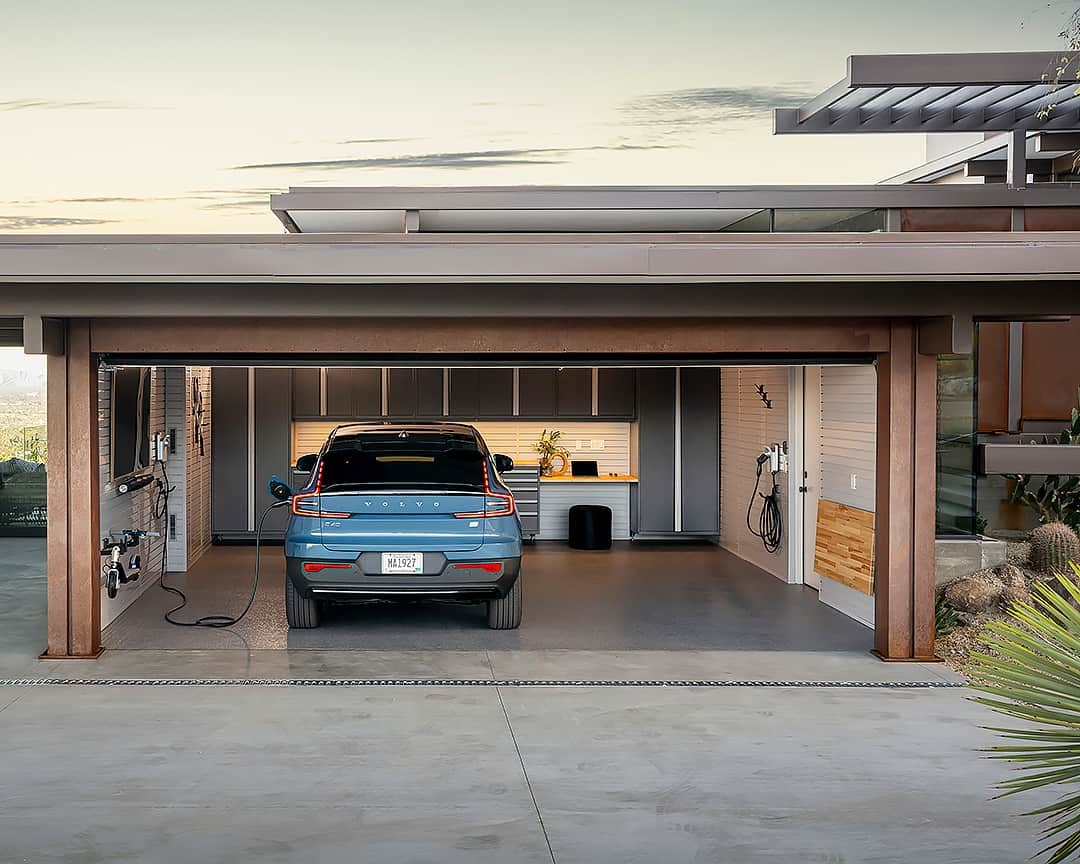
As gas prices soar to record highs and are expected to keep climbing in the immediate future, electric vehicles are looking more appealing to consumers.
Whereas electric vehicles (EVs) were once viewed as a fad or novelty, now it’s widely agreed that electric mobility is the way of the future – whether some of us are ready or not.
The U.S. and Canadian governments each have ambitious plans for environment-friendly EVs to make up half of all sales of new vehicles by 2030. Many major automakers like Volvo, BMW, General Motors, and Mercedes-Benz are investing billions into EV initiatives. Their goal is to completely phase out combustion engines in the next 10-15 years.
If you’re considering buying an EV, you’ll have several questions about what’s involved with EV ownership. One of the most important questions anyone making the switch to electric will have is how an EV home charging setup works.
Don’t worry, we have you covered with everything you need to know about EV home charging.
Electric vehicles come in three types
Anyone new to the world of EVs will probably be confused about the different types of vehicles and what those acronyms commonly used to describe them mean. To provide some clarity, here’s a breakdown:
- Battery electric vehicles (BEV) – also referred to as fully electric vehicles, they are solely battery-powered and have no tailpipe emissions
- Hybrid electric vehicles (HEV) – gas and a battery combine to power the vehicle, with the battery being recharged by the car’s braking system (known as regenerative braking)
- Plug-in hybrid electric vehicles (PHEV) – a combination of gas and a battery power the vehicle, with the battery recharging through both regenerative braking and plugging into a standard home electrical outlet.
EV home charging is the most practical charging solution
You may be wondering why it’s so important to have an EV home charging setup when public charging stations are available. While public charging infrastructure continues to grow, most drivers still rely on the EV charging solution in their home.
According to the U.S. Department of Energy, there are approximately 43,000 public charging stations in America that provide 120,000 charging ports. Natural Resources Canada shows that 6,000 public charging stations are available across the country.
It will be several years before public charging stations are as easy to find as gas stations. For this reason, charging your EV at home is still the most reliable option.
“Range anxiety” (worrying about having enough battery power to get to a destination) is one of the top concerns for prospective EV buyers. Being able to charge your EV at home significantly helps ease that anxiety and is far more convenient than using public charging stations.
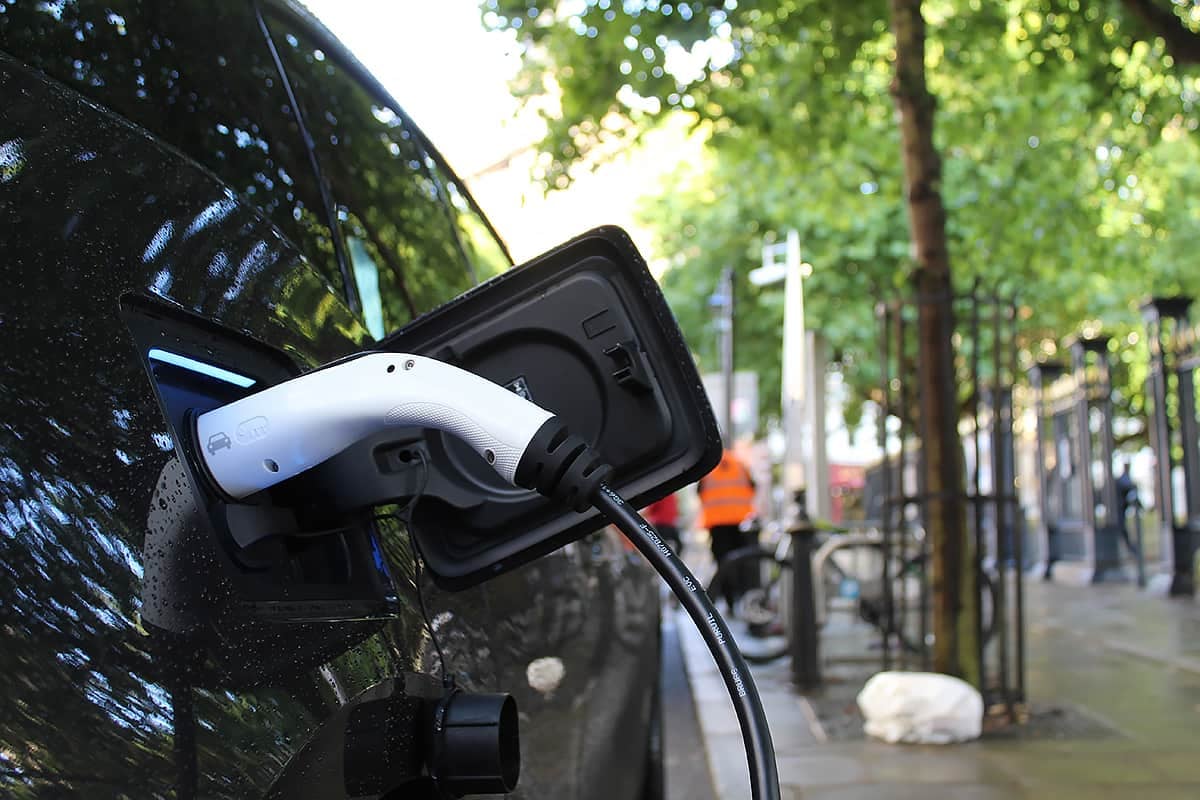
Using a public charging station involves finding a location, potentially waiting for a charging port to become available, and then having to wait while your vehicle charges. Some public charging stations are free to use. Many have rapid charging but come with a fee.
With a garage EV charging station, you can fully charge your vehicles when it is convenient for you.
There are three categories of EV charging
EV charging is broken down into three levels. Here’s what each level means.
Level 1
This is the most basic level of charging. BEVs and PHEVs come with a 120-volt charging cable that plugs on one end into the vehicle’s charge port and the other end is plugged into a standard household electrical outlet.
Because Level 1 is the slowest charging method (about 2-5 miles of range per hour of charge), it’s most practical for PHEVs that aren’t driven long distances regularly. Most PHEV batteries (which have smaller batteries than BEVs) can be fully recharged overnight.
Level 2
The most common type of EV home charging method is to use a Level 2 charging station, which is also known as EVSE (electric vehicle supply equipment). The chargers can be installed in a garage or outside and plug into the same type of 240-volt outlet that dryers and stoves use.
A Level 2 EV home charging station charges anywhere from three to ten times faster than Level 1 charging and is essential for most owners of fully electric vehicles. PHEV owners who drive a lot may also prefer the convenience of having a faster charging method for their vehicle.
Level 3
The fastest way to charge an EV is with a Level 3 direct current (DC) charger. This is the type that many public charging stations have (Level 2 chargers are also commonly available at the stations).
Most Level 3 chargers can recharge an EV battery from empty to 80% in 30-45 minutes. This charging method uses a 480-volt system, which most houses can’t accommodate.
How to get your garage ready for an EV charger
Getting your EV home charger set up will likely require some electrical work in the garage from a certified electrician to provide the charger’s 240-volt power source.
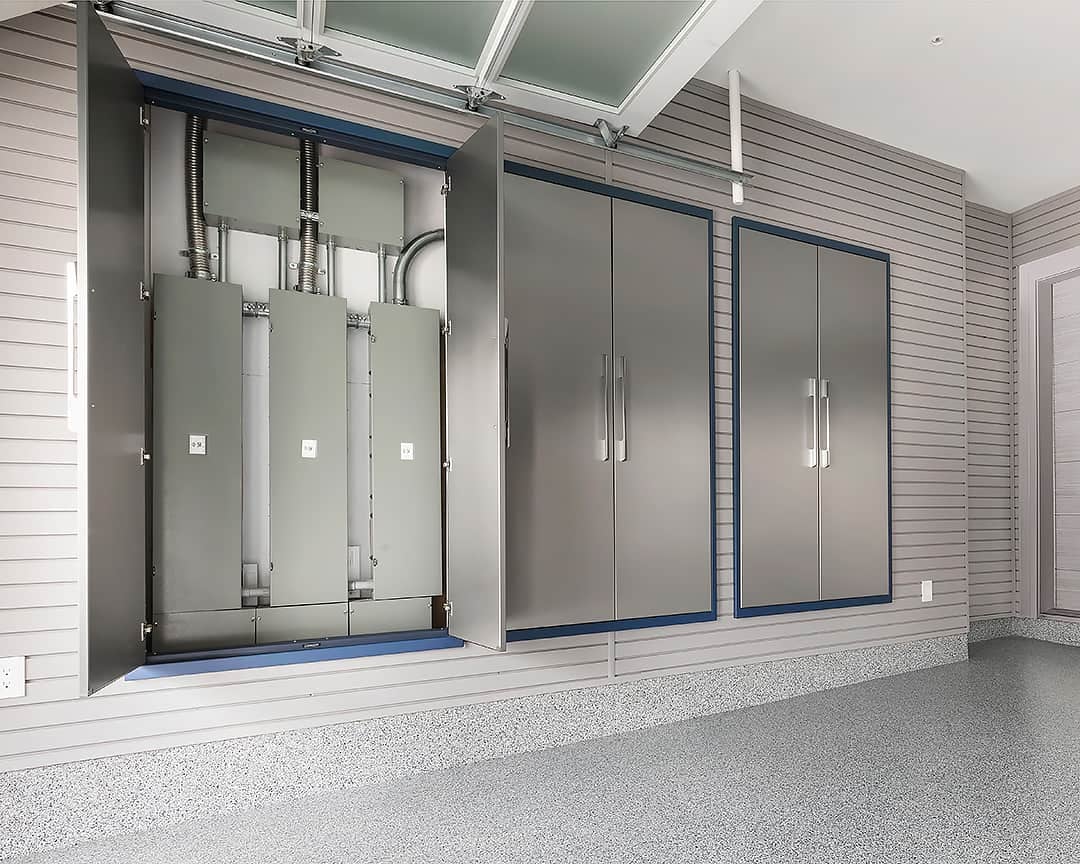
Depending on what type of charger you want, the electrician can simply install a 240-volt outlet on the wall which you can plug the charger into. The other option is to hardwire the wall-mounted charger directly into your electrical panel. Plug-in chargers are easier to install and remove if you’re going to the cottage, eventually move, or want to upgrade the charging system in the future.
Getting your garage EV-ready also requires you to actually have enough space to be able to park inside, install the charger, and have enough room to use it every day. That’s easier said than done in some garages, which 20-25% of homeowners are unable to park in because of clutter.

To get the garage organized and eliminate floor clutter, invest in better storage systems like slatwall panels, cabinetry, and overhead racks to maximize the room’s storage space.
A tidy garage allows easy access to your EV charging station and lets you enjoy the numerous other benefits of parking your cars and trucks indoors.
Choosing the best location for an EV charger
For various reasons, some homeowners choose to have their charging stations installed outside, usually near the garage entrance or at the side of their house. They’ll need to ensure the charger they buy is certified for outdoor use. Proper EV chargers can be used safely outdoors, even when it’s raining or snowing.
Most EV owners will have their charger installed in the garage, which is the most ideal location for a few reasons.
First, you won’t have to worry about the charging station, charging cable, or your vehicle being vandalized. You also won’t have to contend with handling wet, muddy cables when there’s precipitation...or being outside in that nasty weather to plug or unplug the vehicle’s charging cable. Parking indoors in extreme cold weather improves the efficiency of the recharging process as well.
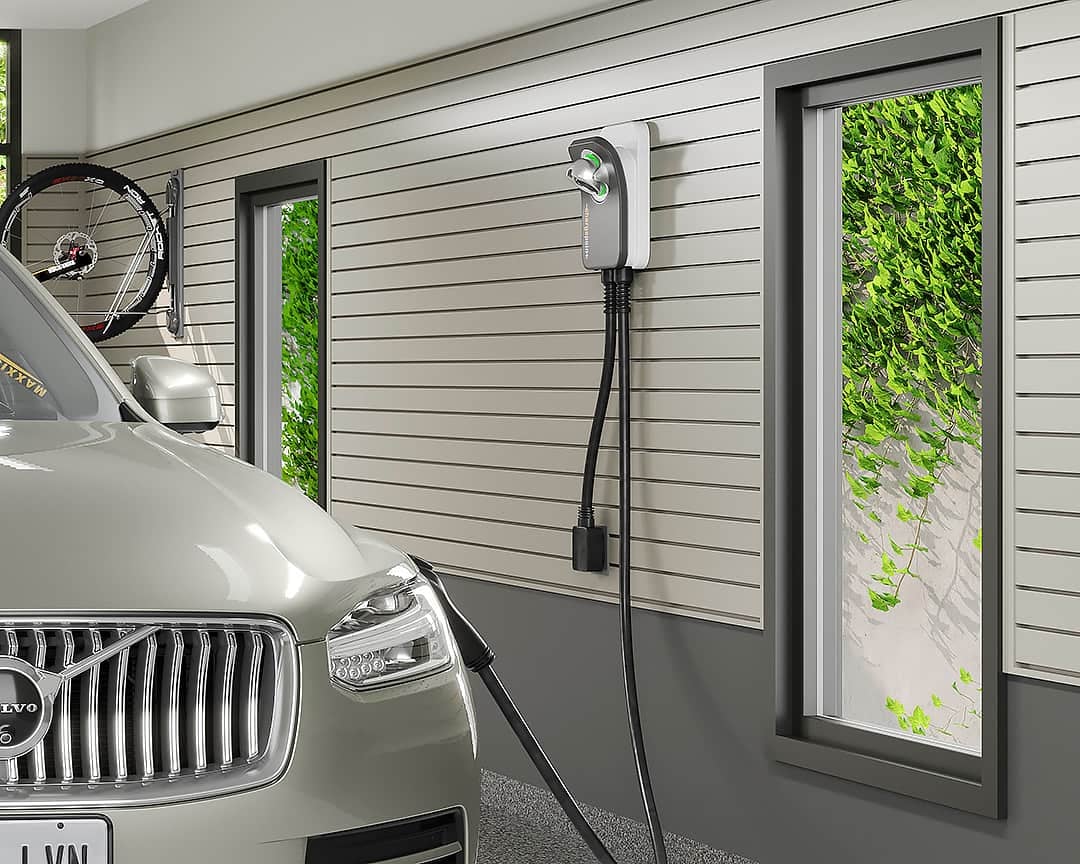
Naturally, an EV charger installed in the garage should be as easy to access as possible. The location of the charging port on the vehicle will be a big factor in where the wall-mounted charger is installed.
Most Level 2 charging cables are 16-20 feet long. For a little more flexibility with your EV charging setup, consider getting an extra-long cable that is 25 feet in length or more. That extra cable length will come in handy if you’re unable to park inside or want to have more space in the garage for a few hours of hobby time.
If you have two or three EVs parked in the garage, that’s another major factor that will dictate the charger’s location. For this type of setup, a centralized location (like on a wall between the garage doors) is the most practical, whether you’re using a single charger, two separate chargers, or a dual charger.
How to choose the right EV home charger
When you’re choosing which EV home charger model to buy, as always, check as many customer ratings of a product as possible and don’t be tempted by too-good-to-be-true prices.
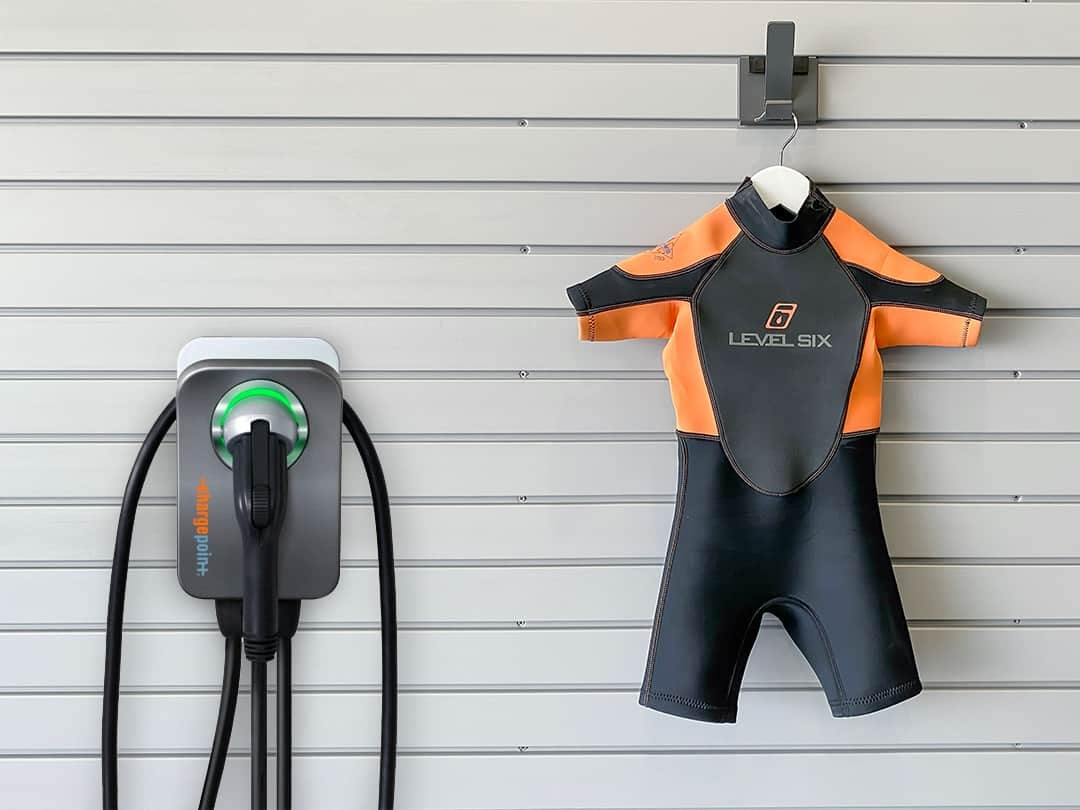
Any Level 2 charger you buy also needs to be safety certified by an accredited testing lab or organization and be Energy Star compliant. Some reputable EV charger brands include:
- ChargePoint
- Siemens
- Bosch
- JuiceBox
- ClipperCreek
Some automakers and car dealerships offer packages with high-quality home charging hardware that has been vetted by them, which helps you start using your charging station that much quicker.
Volvo, for example, favors ChargePoint’s Home Flex model, which was rated the best level 2 home charger by Consumer Reports and Forbes. EV market leader Tesla advises buyers of their cars use the company’s proprietary charging system.
Consider a smart EV charger
Another very useful feature you may want on your EV charger is smart tech that adds convenient functionality. WiFi-connected smart EV charging stations have many benefits that allow you to do several tasks via a mobile app:
- schedule your charging for late evening and overnight hours when electricity rates are cheaper
- check the status of a charging session
- get a detailed history of all of your previous charging sessions
- add new features via software and firmware updates
- get notifications when a charging session is finished
- remotely start or end charging sessions for other EVs you own
- some smart EV chargers are compatible with Amazon’s voice-controlled Alexa virtual assistant
You’ll need a good WiFi signal to get the most out of some of a smart charger’s features. Here are some tips to boost the WiFi signal in your garage.
The cost for a home charging installation
Anyone entering into the new world of EV ownership who plans to use a home charger will have another big question: what will it cost for an EV charger installation?
Let’s start with the cost of getting your home’s electrical system set up to handle an EV charger. Other than the varying amount of each electrician’s hourly rate, these other factors will determine the cost of an installation:
- permit cost (if your municipality requires one)
- additional work for rewiring or upgrading the electrical panel (if needed)
- how far the electrical panel is from the charger
HomeAdvisor found that the national (U.S.) average EV charger installation cost is $750. One expert (Cara Clairman, CEO of Plug ’n Drive, which educates Canadian consumers about EVs) told Wheels.ca that she estimates the cost of an installation to be “anywhere from $500 to $1,200”.
HomeGuide has some great information here about what it costs for an EV charger and installation. They estimate that an installation can range from $400 to $1,700.
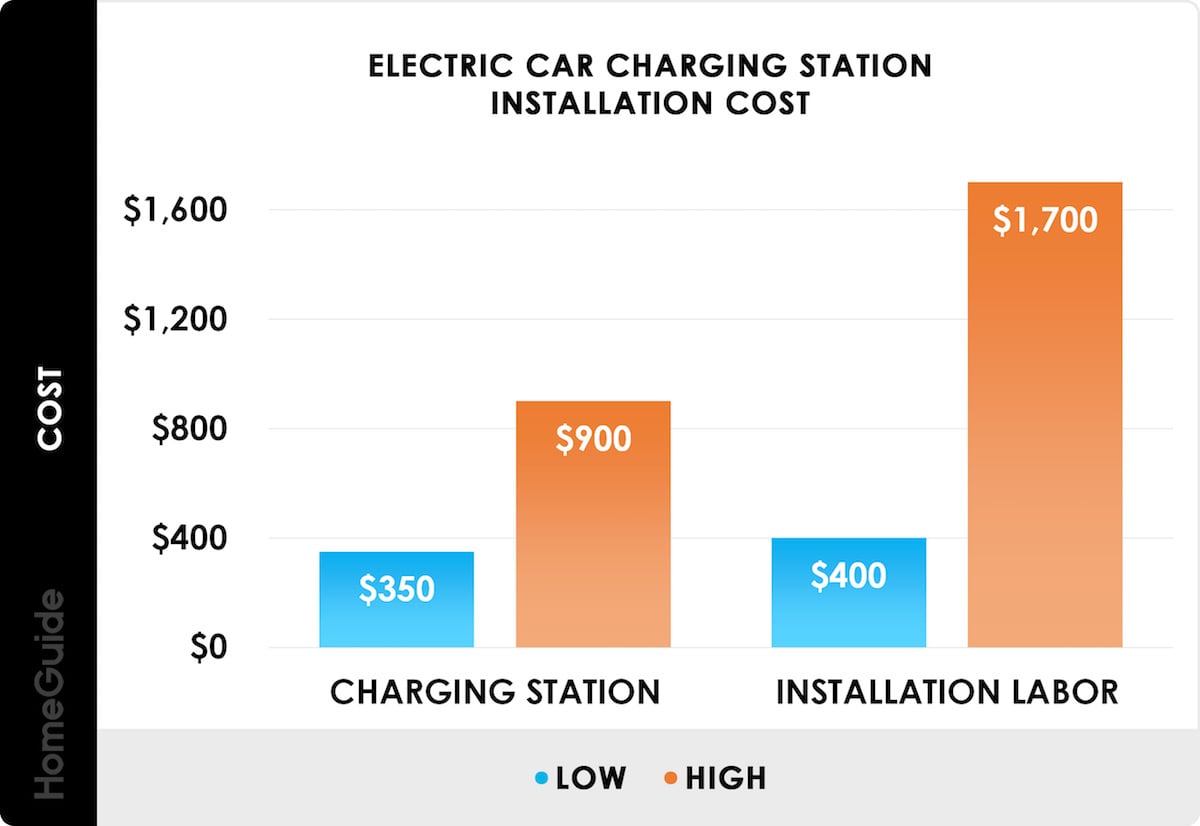
How much an EV home charger costs
HomeGuide’s research shows that a Level 2 charger (without installation) costs anywhere from $350 to $900 on average. For EV chargers with higher amps (which boosts charging speeds and is used for chargers with two ports), you’re looking at between $550 to $2,000.
Smart chargers will cost a little more. Be leery of cheap EV chargers, which can charge at a slower rate and will inevitably deliver less reliable performance over time compared to a higher-quality charger.
The costs of adding an EV charger to your home can seem high, especially after spending a significant amount of money on the vehicle itself.
However, all you have to do is add up the one-time costs of buying and installing a charger and calculate your extra monthly electrical costs for recharging your vehicles.
When you crunch the numbers, there’s no question that it ends up being far more cost-effective to own an EV compared to a gas-powered vehicle – especially these days.
Plus you can feel good about doing your part to reduce your carbon footprint by using a renewable energy source to power your vehicle.
Take advantage of EV incentives
Design and upgrade ideas for garages with EV chargers
Adding an EV charger to your garage will change how it looks and functions to a certain degree. Indoor parking will be a priority (as it should be...that’s what a garage is for, right?), so good organization is essential.
Even though they occupy a relatively small amount of the room’s space, some homeowners may think the sight of a wall-mounted charger and hanging cable negatively impacts the garage’s aesthetic. That’s a valid concern, especially for homeowners who have chosen a specific décor for their garage or are planning to do a major remodel soon.
Garage Living is capable of designing customized cabinets that can hide an EV charger system and its accessories and still keep it easily accessible. This helps the garage look tidier and provides you with additional storage options.
We’ve fulfilled similar requests on previous remodel projects from customers who wanted unsightly utility features like electrical panels, central vac systems, elevator systems, and more hidden away.
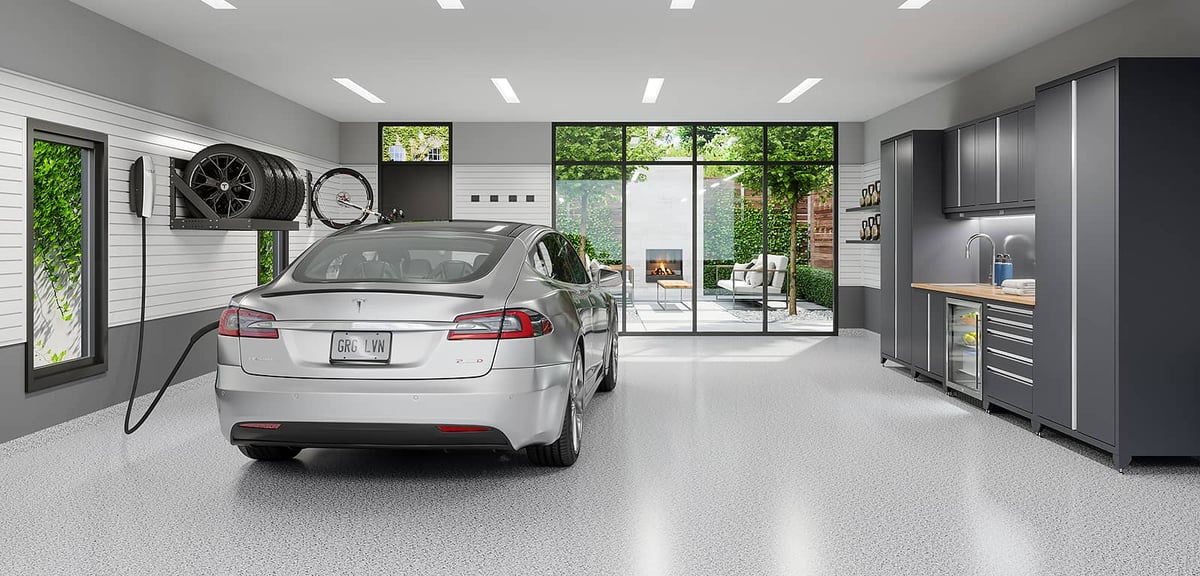
If you’re planning on an upgrade of your garage interior at the same time you’re adding an EV charging station, our ReCHARGE garage design theme may be just right for you. The exclusive theme from our Designer Series features a neutral color palette comprised of nature-inspired shades. This creates a clean, refreshing look that pairs beautifully with an EV home setup.
You’ll want to park your new EV on something nicer than a dusty, cracked, and grey floor. Transform it to make it look as modern as your new ride with a Floortex™ floor coating application.
Finally, it’s worth investing in insulation upgrades for your garage if the room is lacking in that department. Adding wall and ceiling insulation is another impactful way to make your home more energy-efficient and helps you save on your utility costs, too.
Parking EVs in an insulated space also helps the charging process and batteries function more efficiently in extreme cold temperatures.
Is your garage EV-ready?

If you own an EV or are planning to buy one, you’re clearly a forward-thinking person who enjoys being a leader, not a follower.
It’s this type of discerning individual who recognizes that their garage doesn’t have to look like most garages do – dull, outdated, lacking any style, and perpetually disorganized.
The future is now. Is your garage ready for it?
Schedule a free design consultation with us to start getting your garage EV-ready.
Please share this post if you found it useful.